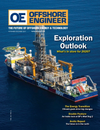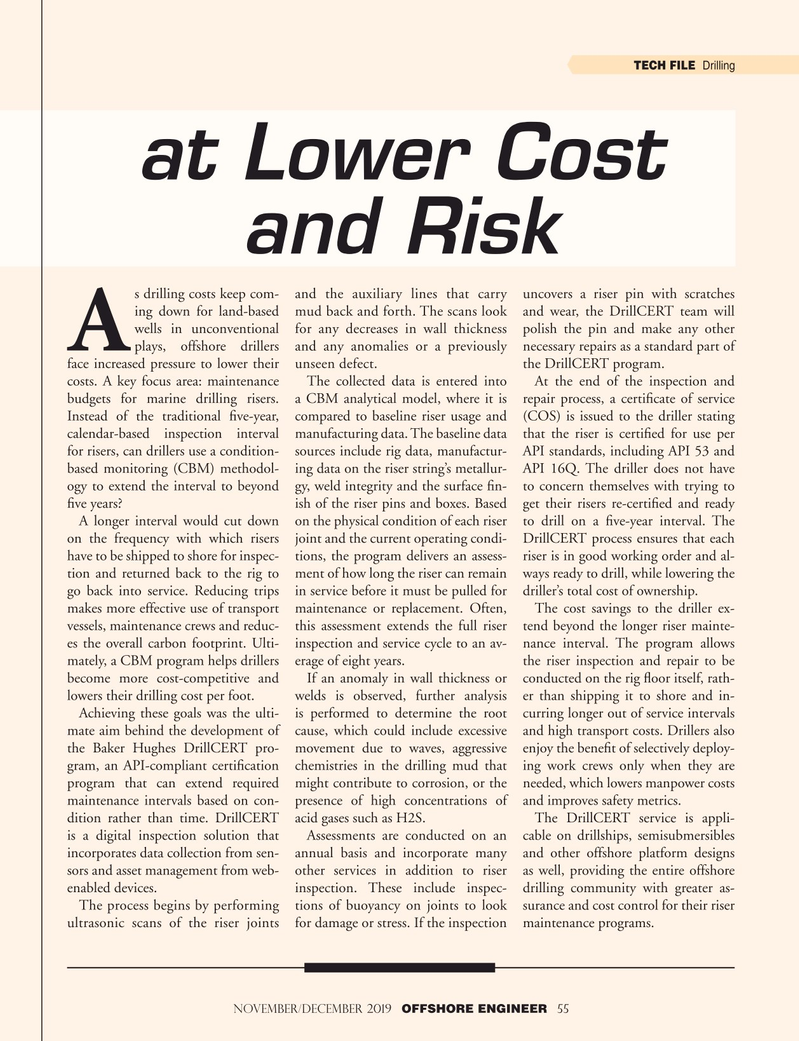
Page 55: of Offshore Engineer Magazine (Nov/Dec 2019)
Exploration Outlook
Read this page in Pdf, Flash or Html5 edition of Nov/Dec 2019 Offshore Engineer Magazine
TECH FILE Drilling at Lower Cost and Risk s drilling costs keep com- and the auxiliary lines that carry uncovers a riser pin with scratches ing down for land-based mud back and forth. The scans look and wear, the DrillCERT team will wells in unconventional for any decreases in wall thickness polish the pin and make any other
A plays, offshore drillers and any anomalies or a previously necessary repairs as a standard part of face increased pressure to lower their unseen defect. the DrillCERT program. costs. A key focus area: maintenance The collected data is entered into At the end of the inspection and budgets for marine drilling risers. a CBM analytical model, where it is repair process, a certi? cate of service
Instead of the traditional ? ve-year, compared to baseline riser usage and (COS) is issued to the driller stating calendar-based inspection interval manufacturing data. The baseline data that the riser is certi? ed for use per for risers, can drillers use a condition- sources include rig data, manufactur- API standards, including API 53 and based monitoring (CBM) methodol- ing data on the riser string’s metallur- API 16Q. The driller does not have ogy to extend the interval to beyond gy, weld integrity and the surface ? n- to concern themselves with trying to ? ve years? ish of the riser pins and boxes. Based get their risers re-certi? ed and ready
A longer interval would cut down on the physical condition of each riser to drill on a ? ve-year interval. The on the frequency with which risers joint and the current operating condi- DrillCERT process ensures that each have to be shipped to shore for inspec- tions, the program delivers an assess- riser is in good working order and al- tion and returned back to the rig to ment of how long the riser can remain ways ready to drill, while lowering the go back into service. Reducing trips in service before it must be pulled for driller’s total cost of ownership. makes more effective use of transport maintenance or replacement. Often, The cost savings to the driller ex- vessels, maintenance crews and reduc- this assessment extends the full riser tend beyond the longer riser mainte- es the overall carbon footprint. Ulti- inspection and service cycle to an av- nance interval. The program allows mately, a CBM program helps drillers erage of eight years. the riser inspection and repair to be become more cost-competitive and If an anomaly in wall thickness or conducted on the rig ? oor itself, rath- lowers their drilling cost per foot. welds is observed, further analysis er than shipping it to shore and in-
Achieving these goals was the ulti- is performed to determine the root curring longer out of service intervals mate aim behind the development of cause, which could include excessive and high transport costs. Drillers also the Baker Hughes DrillCERT pro- movement due to waves, aggressive enjoy the bene? t of selectively deploy- gram, an API-compliant certi? cation chemistries in the drilling mud that ing work crews only when they are program that can extend required might contribute to corrosion, or the needed, which lowers manpower costs maintenance intervals based on con- presence of high concentrations of and improves safety metrics. dition rather than time. DrillCERT acid gases such as H2S. The DrillCERT service is appli- is a digital inspection solution that Assessments are conducted on an cable on drillships, semisubmersibles incorporates data collection from sen- annual basis and incorporate many and other offshore platform designs sors and asset management from web- other services in addition to riser as well, providing the entire offshore enabled devices. inspection. These include inspec- drilling community with greater as-
The process begins by performing tions of buoyancy on joints to look surance and cost control for their riser ultrasonic scans of the riser joints for damage or stress. If the inspection maintenance programs.
NOVEMBER/dECEMBER 2019 OFFSHORE ENGINEER 55

 54
54

 56
56